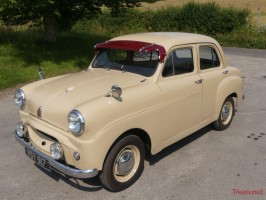

Exploring the Iconic Designs of Post-War Classic Cars is a journey through a period of significant automotive design innovation. This era witnessed a dramatic shift in the automotive landscape, transforming from wartime austerity to post-war prosperity, and influencing car design in profound ways. The classic cars of this period weren’t just transportation; they were statements of societal change and expressions of style. This article dives deep into the key stylistic elements, influential designers, and lasting impact of these remarkable automobiles. We’ll explore the aesthetic characteristics, technological advancements, and overall cultural context that shaped these vehicles, examining the designs’ evolution across decades. This article will focus on specific models and illustrate how different design choices reflected the era’s cultural climate. This comprehensive exploration will offer a compelling look into the history and design ethos of this remarkable time in automotive history.
The Rise of Post-War Design Aesthetics
Early Influences and the Post-War Boom
The years following World War II brought with them a surge in economic activity and a renewed appetite for consumer goods. This post-war boom significantly impacted the automotive industry, leading to a wave of innovative designs. Manufacturers were eager to introduce stylish, powerful, and accessible vehicles that reflected the societal optimism and desires for a brighter future. This pursuit of design excellence marked a turning point in automotive history. The designs often incorporated flowing lines and streamlined silhouettes, moving away from the more utilitarian designs of the war years.
Streamlined Elegance and the Rise of American Icons
Shaping the Post-War Aesthetic
The 1950s ushered in an era of exuberance and boldness in design. American car manufacturers, particularly Ford and Chevrolet, led the charge with designs that featured sleek, sculpted bodies. The quintessential American automobile of this era epitomized the spirit of the times, embodying comfort, power, and prestige. Curved roofs, tapered lines, and bold chrome accents were hallmark features of these iconic vehicles. Consider the distinctive designs of the iconic Chevrolet Bel Air or the stylish Ford Fairlane. These designs reflected the desires of the American public during the period.
European Influence and Sophistication
The Continental Flair
While American designs often focused on expansive proportions and muscular aesthetics, European manufacturers introduced a different perspective. Cars like the Jaguar XK120 and the early models from Mercedes-Benz exhibited refined elegance and sophisticated engineering. These models highlighted the artistry and precision associated with European automotive design. The focus was often on performance and a certain refinement, embodying a more classic and enduring style that contrasted with the boldness of American designs.
Technological Advancements in Post-War Classic Cars
Innovations and their impact
The post-war period witnessed remarkable advancements in automotive technology. Manufacturers incorporated new materials, such as fiberglass and chrome, to create lighter, stronger, and more aesthetically appealing bodies. Innovations in engine design also contributed to the power and performance of these automobiles. The use of advanced materials and more efficient engines dramatically reshaped the driving experience and underscored the period’s technological progress.
Cultural Context and Automotive Design
Reflecting the Social Scene
The designs of post-war classic cars weren’t mere aesthetics; they mirrored the cultural climate of the time. The designs reflected societal values, aspirations, and prevailing trends. Cars became more than just a means of transportation; they were extensions of personal identity and social status. The cultural environment, with its emphasis on family, optimism, and the rise of the middle class, significantly influenced the direction and evolution of these designs. For example, the spacious interiors of some models reflected the growing importance of family vehicles.
Legacy of Post-War Classic Cars
Lasting Impact on Design and Popular Culture
The impact of post-war classic cars extends beyond their aesthetics. These vehicles played a pivotal role in shaping the contemporary automotive design movement. Their bold designs and innovative engineering influenced manufacturers for decades to come. Classic cars of the era continue to capture the hearts and imaginations of car enthusiasts today, demonstrating their enduring cultural significance.
Frequently Asked Questions
Q1: What are some key factors that influenced post-war classic car designs?
A1: Post-war classic car designs were significantly shaped by a confluence of factors. The economic recovery after World War II spurred innovation and consumer desire for new vehicles. Rising disposable incomes fueled demand for more stylish and sophisticated automobiles. The burgeoning industrialization and new materials like chrome and fiberglass had a significant impact on the look and feel of the designs. Furthermore, international influences and design trends played a critical role, fostering a dynamic and diverse aesthetic in the post-war era. This interplay of factors produced a unique period in automotive history, marked by innovation and iconic designs.
Q2: How did post-war classic cars contribute to the automotive design movement?
A2: Post-war classic cars were a crucial part of the automotive design movement. Their bold designs and innovative engineering pushed the boundaries of what was possible, influencing future generations of car designers. The use of new materials, sophisticated aerodynamic considerations, and emphasis on form and function served as a testament to the period’s design ethos. These cars aren’t just beautiful; they’re also a critical link in the evolution of automotive design, inspiring later styles and highlighting the impact of societal shifts on design choices.
In conclusion, exploring the iconic designs of post-war classic cars offers a fascinating journey through automotive history. From streamlined elegance to powerful engineering, these vehicles showcase remarkable design innovation. Learning about their evolution, influence, and impact enriches our understanding of automotive design and societal shifts. If you’re fascinated by design, history, or classic cars, I highly recommend delving deeper into this subject; you’ll undoubtedly find compelling stories and beautiful designs waiting to be discovered. Consider checking out specialized car museums or exploring online resources for further exploration.